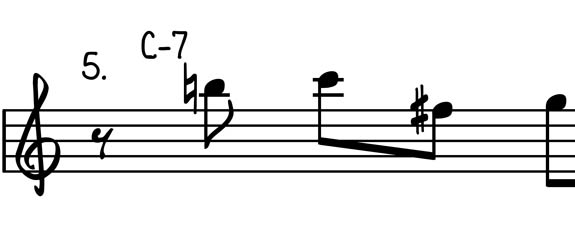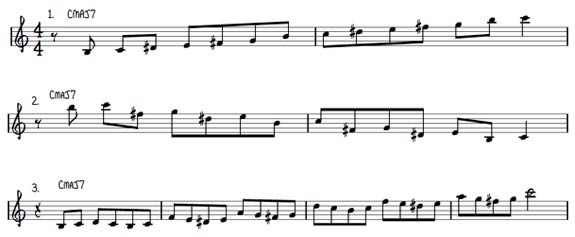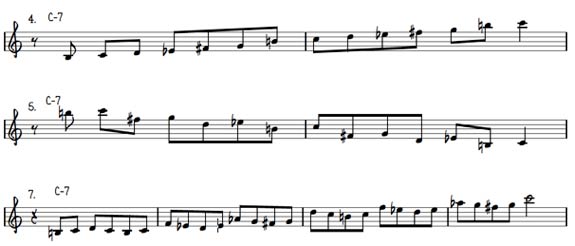How To Keep Your Solos Fresh Using Lower Neighbor Tones
 One of the most basic and important truths of improvising is that no matter what note you play, you’re never more than a half-step away from the “right” note. Besides being a comforting thing to know, this truth might actually help you get out of a musical jam, and could also help you expand your musical vocabulary in profound ways.
One of the most basic and important truths of improvising is that no matter what note you play, you’re never more than a half-step away from the “right” note. Besides being a comforting thing to know, this truth might actually help you get out of a musical jam, and could also help you expand your musical vocabulary in profound ways.
But before we go there, why did I put the word “right” in quotations? Because as you progress as an improviser and learn more of the foundations of melody and harmony, you will realize that there really are no wrong notes. Instead, there are some notes that fit easily into the chord and make a consonant sound and other, more dissonant notes that need to be treated in particular ways or with particular intent to make them work.
So after learning your basic chord/scale relationships, you may want to start adding some of the more chromatic, dissonant notes into your playing.
Here’s a simple way to get you started.
Go to the nearest piano or keyboard (hopefully you always have one nearby when you’re practicing) and plunk out a C triad with your left hand (C-E-G). Now, with your right hand, play the note a half step below each of those notes before playing each of the notes in the chord. In other words, play F# to G, then D# to E, then B to C. In fancy language, these notes are the chromatic lower neighbor tones to the notes in the C triad. When you play this together with the triad in the left hand, or even a Major 7th chord, you’ll hear that each one creates a brief dissonance (a feeling of musical tension) before resolving to the consonant note which is in the triad. In more traditional music theory, this dissonance that resolves by step movement up or down is called a suspension.
Once you know what these notes are, you will start to hear them used all over the place, from the music of Handel and Bach up into Coleman Hawkins, Lester Young, Charlie Parker and Sonny Rollins. They are one of the most simple ways to get you started using chromaticism in your playing.
Here are some basic patterns (download the more readable PDF sheet music here) that utilize your lower tones which you can practice, hopefully in all twelve keys. Let’s start with some in Major key.

Here are some in minor key.

And now here is an eight bar excerpt of Rhythm Changes in C that illustrate how they can be used in jazz improvisation.

So jump into the shed and see what you can come up with. Write your ideas down if you have to, and make sure that you work these out with a chordal instrument like the piano so that you really hear what each note sounds like in relationship to the chord.
CLICK HERE TO DOWNLOAD COMPLETE SHEET MUSIC IN MUCH MORE READABLE PDF FORMAT.
Learn with and Listen to Sam
Sam Sadigursky is currently offering online lessons through Skype and private lessons in NYC. He has given improvisation clinics across the U.S., is a regular guest professor at Hunter College, and currently performs internationally with Darcy James Argue’s Secret Society, Folklore Urbano, and others. His new book, 12 INTERVALLIC ETUDES for Saxophone, is available here. His albums can be purchased at http://samsadigursky.bandcamp.com. To find out more, visit SamSadigursky.com.






March 20, 2015 @ 3:10 pm
thanks for info
May 30, 2015 @ 9:56 am
The best way to approach chromatic passing tones is the way Barry Harris teachs. it’s sounds elementary but if you start to dig it you’ll become aware of the huge possibility this way offer sintetically you can concentrate the all thing in few words: ON THE DOWNBEAT PLAY ONLY NOTES OF THE CHORD/TONALITY, ON THE OFFBEAT PLAY WHATEVER YOU WANT.
Be aware of the fact that between 3rd en 4th and 7th en 1st in maj and between 2nd en 3rd and 7th and 1st in min mel. (min harm. is even moore triky) there is an halfstep interval which made the all thing quite complex. best regards. Ben Weiss Levi